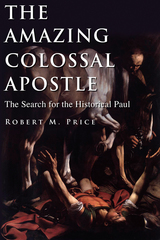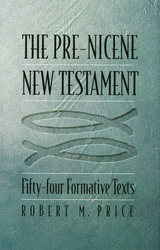2 books about Price, Robert M.

The Amazing Colossal Apostle
The Search for the Historical Paul
Robert M. Price
Signature Books, 2012
The story of Paul is one of irony, the New Testament depicting him at the martyrdom of Stephen holding the assassins' cloaks. Then this same Paul is transformed into the biblical archetype for someone suffering for their faith. He becomes so entrenched, it would appear that he had walked with the Christians all his life, that he was the one who defined the faith, eventually being called the “second founder of Christianity.” But much of what we think we "know" about Paul comes from Sunday school stories we heard as children. The stories were didactic tales meant to keep us reverent and obedient.
As adults reading the New Testament, we catch glimpses of a very different kind of disciple—a wild ascetic whom Tertullian dubbed “the second apostle of Marcion and the apostle of the heretics.” What does scholarship tell us about the enigmatic thirteenth apostle who looms larger than life in the New Testament? The epistles give evidence of having been written at the end of the first century or early in the second—too late to have been Paul’s actual writings. So who wrote (and rewrote) them? F. C. Baur, a nineteenth-century theologian, pointed persuasively to Simon Magus as the secret identity of “Paul.” Robert M. Price, in this exciting journey of discovery, gives readers the background for a story we thought we knew.
As adults reading the New Testament, we catch glimpses of a very different kind of disciple—a wild ascetic whom Tertullian dubbed “the second apostle of Marcion and the apostle of the heretics.” What does scholarship tell us about the enigmatic thirteenth apostle who looms larger than life in the New Testament? The epistles give evidence of having been written at the end of the first century or early in the second—too late to have been Paul’s actual writings. So who wrote (and rewrote) them? F. C. Baur, a nineteenth-century theologian, pointed persuasively to Simon Magus as the secret identity of “Paul.” Robert M. Price, in this exciting journey of discovery, gives readers the background for a story we thought we knew.
[more]

The Pre-Nicene New Testament
Fifty-four Formative Texts
Robert M. Price
Signature Books, 2006
In this monumental work, Professor Price offers an inclusive New Testament canon with twenty-seven additional sacred books from the first three centuries of Christianity, including a few of the Dead Sea Scrolls and Nag Hammadi writings. Price also reconstructs the Gospel of Marcion and the lost Gospel according to the Hebrews. Here, for the first time, is a canon representing all major factions of the early church.
As an interpretive translation, Price’s text is both accurate and readable and is tied more closely to the Greek than most previous translations. Price conveys the meanings of words in context, carefully choosing the right phrase or idiom to convey their sense in English. For words that had a specific theological import when first written, Price leaves the Greek transliteration, giving readers archons for the fallen angels thought to be ruling the world, paraclete for encourager, andpleroma for the Gnostic godhead.
Within the collection, each book is introduced with comments about the cultural setting, information about when a document was probably written, and significant textual considerations, which together form a running commentary that continues into the footnotes. The findings of scholars, documented and summarized by Price, will come as a surprise to some readers. It appears, as Price suggests, that most of what is known about Jesus came by way of revelation to Christian oracles rather than by word of mouth as historical memory. In addition, the major characters in the New Testament, including Peter, Stephen, and Paul, appear to be composites of several historical individuals each, their stories comprising a mix of events, legend, and plot themes borrowed from the Old Testament and Greek literature.
In the New Testament world, theology developed gradually along different trajectories, with tension between the charismatic ascetics such as Marcion and Thecla, as examples, and the emerging Catholic orthodoxy of such clergy as Ignatius and Polycarp. The tension is detectable in the texts themselves, many of which represent “heretical” points of view: Gnostic, Jewish-Christian, Marcionite, and proto-orthodox, and were later edited, sometimes clumsily, in an attempt to harmonize all into one consistent theology.
What may occur to many readers, among the more striking aspects of the narratives, is that the earliest, most basic writings, such as Mark’s Gospel in inarticulate Greek, are ultimately more impressive and inspirational than the later attempts by more educated Christians to appeal to sophisticated readers with better grammar and more allusions to classical mythology and apologetic embellishments.
The critical insights and theories on display in these pages have seldom been incorporated into mainstream conservative Bible translations, and in many ways, Price has made the New Testament a whole new book for readers, allowing them, by virtue of the translation, to comprehend the meaning of the text where it is obscured by the traditional wording. Whatever usefulness teachers, students, and clergy may find here in terms of pedagogical and inspirational value, The Pre-Nicene New Testament is guaranteed to provoke further thought and conversation among the general public—hopefully toward the goal of more personal study and insights.
As an interpretive translation, Price’s text is both accurate and readable and is tied more closely to the Greek than most previous translations. Price conveys the meanings of words in context, carefully choosing the right phrase or idiom to convey their sense in English. For words that had a specific theological import when first written, Price leaves the Greek transliteration, giving readers archons for the fallen angels thought to be ruling the world, paraclete for encourager, andpleroma for the Gnostic godhead.
Within the collection, each book is introduced with comments about the cultural setting, information about when a document was probably written, and significant textual considerations, which together form a running commentary that continues into the footnotes. The findings of scholars, documented and summarized by Price, will come as a surprise to some readers. It appears, as Price suggests, that most of what is known about Jesus came by way of revelation to Christian oracles rather than by word of mouth as historical memory. In addition, the major characters in the New Testament, including Peter, Stephen, and Paul, appear to be composites of several historical individuals each, their stories comprising a mix of events, legend, and plot themes borrowed from the Old Testament and Greek literature.
In the New Testament world, theology developed gradually along different trajectories, with tension between the charismatic ascetics such as Marcion and Thecla, as examples, and the emerging Catholic orthodoxy of such clergy as Ignatius and Polycarp. The tension is detectable in the texts themselves, many of which represent “heretical” points of view: Gnostic, Jewish-Christian, Marcionite, and proto-orthodox, and were later edited, sometimes clumsily, in an attempt to harmonize all into one consistent theology.
What may occur to many readers, among the more striking aspects of the narratives, is that the earliest, most basic writings, such as Mark’s Gospel in inarticulate Greek, are ultimately more impressive and inspirational than the later attempts by more educated Christians to appeal to sophisticated readers with better grammar and more allusions to classical mythology and apologetic embellishments.
The critical insights and theories on display in these pages have seldom been incorporated into mainstream conservative Bible translations, and in many ways, Price has made the New Testament a whole new book for readers, allowing them, by virtue of the translation, to comprehend the meaning of the text where it is obscured by the traditional wording. Whatever usefulness teachers, students, and clergy may find here in terms of pedagogical and inspirational value, The Pre-Nicene New Testament is guaranteed to provoke further thought and conversation among the general public—hopefully toward the goal of more personal study and insights.
[more]
READERS
Browse our collection.
PUBLISHERS
See BiblioVault's publisher services.
STUDENT SERVICES
Files for college accessibility offices.
UChicago Accessibility Resources
home | accessibility | search | about | contact us
BiblioVault ® 2001 - 2024
The University of Chicago Press









